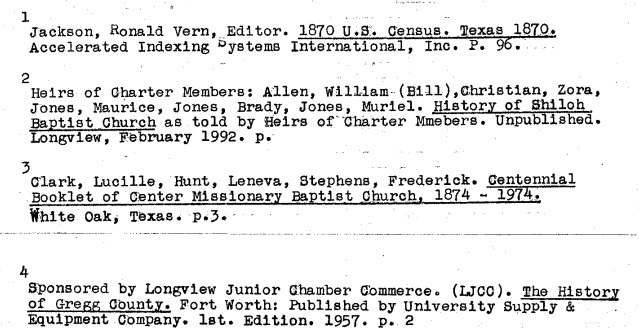This blog has been created for the purpose of helping US History students with their work, assignments, and notes. Work and notes can be printed from this blog. It will also be a platform of the study of American Black History with a timeline and notes.
Sunday, September 17, 2023
Wednesday, September 13, 2023
The History of Shiloh Baptist Church, Longview Texas Part 2
The History of Shiloh Baptist Church, Longview Texas - Part 2
Author Note: They say everyone learns something new everyday. That is so true- for I was not aware of the history of the Shiloh Baptist Church in Longview, Texas (White Oak area) until a couple of weeks ago, when my brother-in-law, the Rev. Robert Morgan Jr. was installed as the church's new pastor. So I decided to do a series on the rich history of the church. I will be posting more articles on the Black History in East Texas. Coming soon, I plan on doing an article on the Mayflower community and how it pertains to Black History.
The area around Shiloh was a part of Mexico in 1821. Many Cherokee families passed through the region during the following decade, having been pushed further west out of their original lands. The Cherokees were forced out of the region by 1839 as many Anglo-Americans arrived in the area as well as some African Americans, some of them enslaved. Through the mid-1800s, the region's main economic activity was cotton farming, and the lumber industry grew after the 1860s.
Shiloh
was one of a number of Black communities to be settled in the county in the Reconstruction
Era. According to local tradition, a formerly enslaved man, Butcher Christian,
his former enslaver, Gideon Christian, and a noted post-Civil War church
organizer, the Reverend John Baptist, established the Shiloh Baptist Church in
1871. Services
began in a log sanctuary located on 3 acres (12,000 m2) donated
by Butcher Christian. Gideon Christian, originally from South Carolina, had
held thirty-two people enslaved in the area prior to the Civil War. According
to the oral histories of local families, the Christian family conveyed land
titles to a number of the emancipated people they had formerly held enslaved.
Adjacent
to the Baptist Church is an active cemetery with marked graves dating to 1882. Shortly
after the end of the Civil War, the newly free Black community established a
one-room school in Shiloh that operated until the school was destroyed in a
major storm in the 1890s. The Shiloh community built a new two-room school
erected in 1920.
Revenues
from oil discovered on church land were used to build a new sanctuary here in
1936.
By the
1960s, oil was the dominant industry of the region, and few farms remained. Shiloh
School closed in 1966, when area schools were desegregated and children
from Shiloh enrolled in White Oak Independent School District. The school
building was later used for chemical storage until it was damaged in a 1993
chemical fire, possibly a result of arson. Shiloh's population declined after World War II. By the 1990s, the church and some of the early settling families remained, but much of the population had moved away. The building, on Shiloh Road, is
marked by a historical plaque. Shiloh Baptist Church still serves the
community with a variety of programs.
Source: Wikipedia
Monday, September 11, 2023
The History of Shiloh Baptist Church, Longview Texas Part I
Rev. John
Baptist, according to the United States 1870 census, was an African American
who lived in Liberty County, Texas. He had a wife, Peggy, and no children. According
to the heirs of the charter members of Shiloh Baptist Church, Rev. Baptist was
a traveling minister who went from place to place and organized churches for
recently freed slaves. The slave-master, Mr. Gedeon Christian secured the
services of Rev. Baptist to aid blacks of the Shiloh Community in organizing
Shiloh Baptist Church. Three years later (1874), he organized the neighboring
Center Baptist Church in the Camp Switch.
Shiloh
was a small rural community comprising of only a portion of Gregg County’s 284
square miles in 1882. While farming was the chief industry, domestic workers,
logging, and saw-milling were minor industries that provided employment for
black residents in rural communities. There were no known businesses or public
institutions in the Shiloh Community during this era. Shiloh Baptist Church was
the only black church in the community. Later in 1885, a 20 X 30 ft. one room
frame school building was used for church services by whites in the neighboring
White Oak community.
After the
Civil War and after the slaves learned that they were fee (June 19, 1865),
there were many problems and hardships. Most slaves had not learned to read or
write. Texas declared that black education would have to be funded by black tax
payers. However, there were few black property owners and jobs to fund their
own schools. As a result, black children were denied an education. It was
during this time, the 1870s and up to the 1890s that school was held in Shiloh
Baptist Church. It is not known how many
students attended the Shiloh Church School, but it was open to all children of
the community regardless to religious beliefs.
The
Shiloh Baptist Church Cemetary is active and adjacent to the church property.
The cemetery was established in 1892. It is not known who the first person was
that was buried there. The Shiloh Historical Research Committee surveyed the
Shiloh Cemetary and discovered that there were unmarked graves or marked only
with a rock as a headstone with no indication of who was buried there.
Notes taken from the following sources:
Tuesday, September 5, 2023
US History 2023-2024: Chapter 3. Industrialization, 1865-1901
Mr. E's US History and Black History Page
Chapter 3. Industrialization, 1865-1901











































.jpg)







